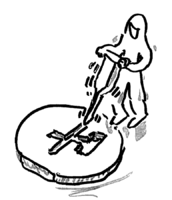Specific Process Knowledge/Direct Structure Definition: Difference between revisions
Jump to navigation
Jump to search
THIS PAGE IS UNDER CONSTRUCTION
| Line 109: | Line 109: | ||
|-style="background:LightGrey; color:black" | |-style="background:LightGrey; color:black" | ||
!Prerequisites | !Prerequisites | ||
|Sample with resist.<br> A glass mask with desired pattern. For mask layout software see [[Specific Process Knowledge/Lithography/UVLithography/Mask Design| Mask design]] | |||
|Sample with resist.<br> A 3D CAD model file in GWL format. Included software can convert 3D model in STL (Standard Tessellation Language) format to GWL files. | |||
|Sample with polymer.<br> A stamp with the wanted pattern, usually in Si or SiO\rm{_2} however other materials could also be used. | |||
|A stamp/shim with the wanted pattern, usually in Ni og Al. | |||
|A 2D CAD model file in DXF or CONX format. [[Specific Process Knowledge/Lithography/UVLithography/Mask Design| Clewin5]] can convert GDS and CIF files to DXF format. | |||
|Number of lines and pitch in each direction. Your wafer. | |||
|- | |- | ||
| Line 120: | Line 120: | ||
|-style="background:LightGrey; color:black" | |-style="background:LightGrey; color:black" | ||
!Throughput (when mask/stamp/pattern available) | !Throughput (when mask/stamp/pattern available) | ||
|medium: 5-10 wafers/hour depending on exposure time | |||
|slow: 1 sample/day | |||
|medium: 5-10 wafers/hour depending on imprint time | |||
|fast: 10-100/hour | |||
|medium-slow: 0.1-1 wafers/hour depending on pattern complexity | |||
|medium: ½-3 wafers/hour depending on material and # of cuts (Si cuts at 5mm/s, SiO2 at 0.5-1 mm/s) | |||
|- | |- | ||
| Line 131: | Line 131: | ||
|-style="background:WhiteSmoke; color:black" | |-style="background:WhiteSmoke; color:black" | ||
!Min/max featuresize | !Min/max featuresize | ||
|1µm - wafer size | |||
|100nm - mm | |||
|100nm - µm | |||
|nm - mm | |||
|100µm - wafer size | |||
|saw blade width 60µm or 200µm. Has to cut full diameter of wafer. | |||
|- | |- | ||
| Line 142: | Line 142: | ||
|-style="background:LightGrey; color:black" | |-style="background:LightGrey; color:black" | ||
!Min/max aspect-ratio | !Min/max aspect-ratio | ||
|NA | |||
|2-Photon Polymerization Lithography ?? | |||
|Nano Imprint Lithography ?? | |||
|Polymer Injection Molder ?? | |||
|50-100µm width/~1mm depth, sloping walls | |||
|60µm width/2mm depth, vertical walls | |||
|- | |- | ||
| Line 153: | Line 153: | ||
|-style="background:WhiteSmoke; color:black" | |-style="background:WhiteSmoke; color:black" | ||
!Post-treatment | !Post-treatment | ||
|resist developing/baking | |||
|resist developing/baking, ?? 2-Photon Polymerization Lithography | |||
|Dry Etch back (RIE), ?? Nano Imprint Lithography | |||
|None, ??Polymer Injection Molder | |||
|Sample cleaning with Ultrasound etc. | |||
|None | |||
|- | |- | ||
| Line 164: | Line 164: | ||
|-style="background:LightGrey; color:black" | |-style="background:LightGrey; color:black" | ||
!Patterning degree of freedom | !Patterning degree of freedom | ||
|2D | |||
|3D | |||
|2D. different depths possible | |||
|2D. different depths possible | |||
|2D. different depths possible | |||
|1D. different depths possible | |||
|- | |- | ||
| Line 206: | Line 206: | ||
|-style="background:LightGrey; color:black" | |-style="background:LightGrey; color:black" | ||
!Allowed materials | !Allowed materials | ||
|UV Lithography | |||
|2-Photon Polymerization Lithography | |||
|Nano Imprint Lithography | |||
|Polymer Injection Molder | |||
|Laser Micromachining Tool | |||
|Dicing saw | |||
|- | |- | ||
Revision as of 10:56, 25 November 2014
Feedback to this page: click here
THIS PAGE IS UNDER CONSTRUCTION
Direct Structure Definiton
By direct structure definition we mean that you form the structures for you device directly in the material that the device consist of without any masking steps. Some of the techniques may require a master.
Choose method of structuring/equipment
- UV Lithography
- 2-Photon Polymerization Lithography
- Nano Imprint Lithography
- Polymer Injection Molder
- Laser Micromachining Tool/ablation
- Dicing saw
Comparison of equipment/material
| UV Lithography | 2-Photon Polymerization Lithography | Nano Imprint Lithography | Polymer Injection Molder | Laser Micromachining Tool | Dicing saw | |
|---|---|---|---|---|---|---|
| General description | The device is typical made in a thick film (10-100µm thick) of a polymer (SU-8) that is spun on a carrier (silicon wafer). This film is exposed through a mask and then developed and possible cured to make the polymer harder. | The device is typical made in a thick film (1-10µm thick) of a polymer (SU-8) that is spun on a carrier (silicon wafer). This film is exposed by two intersecting laser beams in the system. Where the beams intersect the film polymerize and becomes less solvable. It is possible to form very small 3D structures | The device is typical made in a thick film (1-10µm thick) of a polymer that is spun on a carrier (silicon wafer). A master with the desired pattern is pressed into this film and the film is hardened by heating or UV-exposure. A residual layer has to be etched away by dry etching. It is possible to form very small 2½D structures over large areas relative fast. | The device is typical made in TOPAS or a similar polymer/plastic. A master disk of e.g. Nickel, called a shim, with the desired pattern is mounted in the tool of the machine and they form together a void where the melted plastic is injected into. It is possible to form small and large 2½D structures on the chosen shape (determined by the tool) relative fast. As an example Lego building blocks are made by polymer injection molding. | The device is made using a series of short, high intensity light pulses to engrave a pattern in almost any material. Since the light pulses are very short (100ns or 10ps) the heating of the sample can be minimized, and material can be removed without any further sample deformation/melting. | The dicing saw is mostly used to seperate a silicon/glass wafer into individual chips. It can however also be used to make straight channels in glass/fused silica for e.g. fluidic components. |
| Typical used for | Optical waveguides, fluidic systems (master for PDMS/soft lithography) | Photonic bandgap structures | ?? | Fluidic devices, optical waveguides, surface modification. | Cutting Silicon and glass wafers in odd shapes, shim cutting, shim patterning, surface modification, hole drilling in glass/silicon etc. | Cutting Silicon and glass wafers in rectangular shapes, making straight channels in glass wafers. |
| Processable materials |
|
|
|
|
|
|
| Prerequisites | Sample with resist. A glass mask with desired pattern. For mask layout software see Mask design |
Sample with resist. A 3D CAD model file in GWL format. Included software can convert 3D model in STL (Standard Tessellation Language) format to GWL files. |
Sample with polymer. A stamp with the wanted pattern, usually in Si or SiO\rm{_2} however other materials could also be used. |
A stamp/shim with the wanted pattern, usually in Ni og Al. | A 2D CAD model file in DXF or CONX format. Clewin5 can convert GDS and CIF files to DXF format. | Number of lines and pitch in each direction. Your wafer. |
| Throughput (when mask/stamp/pattern available) | medium: 5-10 wafers/hour depending on exposure time | slow: 1 sample/day | medium: 5-10 wafers/hour depending on imprint time | fast: 10-100/hour | medium-slow: 0.1-1 wafers/hour depending on pattern complexity | medium: ½-3 wafers/hour depending on material and # of cuts (Si cuts at 5mm/s, SiO2 at 0.5-1 mm/s) |
| Min/max featuresize | 1µm - wafer size | 100nm - mm | 100nm - µm | nm - mm | 100µm - wafer size | saw blade width 60µm or 200µm. Has to cut full diameter of wafer. |
| Min/max aspect-ratio | NA | 2-Photon Polymerization Lithography ?? | Nano Imprint Lithography ?? | Polymer Injection Molder ?? | 50-100µm width/~1mm depth, sloping walls | 60µm width/2mm depth, vertical walls |
| Post-treatment | resist developing/baking | resist developing/baking, ?? 2-Photon Polymerization Lithography | Dry Etch back (RIE), ?? Nano Imprint Lithography | None, ??Polymer Injection Molder | Sample cleaning with Ultrasound etc. | None |
| Patterning degree of freedom | 2D | 3D | 2D. different depths possible | 2D. different depths possible | 2D. different depths possible | 1D. different depths possible |
| Sample sizes |
|
|
|
flat disk tool: , luer tool: |
|
|
| Allowed materials | UV Lithography | 2-Photon Polymerization Lithography | Nano Imprint Lithography | Polymer Injection Molder | Laser Micromachining Tool | Dicing saw |
